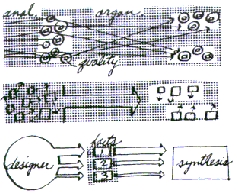|
|
ARCH 5395
Research / Schematics (3:3:1)
Instructors: Michael Peters
(Office: 409)
Dr. Hendrika Buelinckx |
 |
ARCH 5202, 5363,
and 5402
Individual study,
research and conferences to complete research, develop program and schematics
for a comprehensive architectural terminal project in ARCH 5692. Outside
assignments as required.
This semester constitutes
the beginning of the terminal architectural project, which will be concluded
during the following semester. A balance will be struck between the
theoretical and the pragmatic. An architectural topic will be identified,
studied, and articulated as an area of focus for the design. A facility
type will be defined and programmed to act as a vehicle for the design
and theoretical explorations, which will be the focus of the terminal project.
A location for the project will be identified and analyzed for potential
design response. A publication which remains with the college as
part of its permanent collection will be produced by each student as a
portion of the requirements for graduation and as a written statement of
design intent.
In addition, initial
schematic studies will be completed that graphically illustrate concepts
developed in the program and lead into the design of the terminal project.
· To associate
issues and ideas with potential design responses.
· To use established
facility programming methods and techniques to establish design parameters.
· To associate context
issues with potential design responses.
· To design, organize,
write and publish a document to record all of the above.
· To develop design
schematics based on the program document leading to a comprehensive architectural
terminal project.
Class will meet
MWF from 10:00-10:50 a.m. in Room 405/605 unless otherwise announced.
In general, Monday's class will be a lecture and Wednesday and Friday classes
will be for review and individual conferences. Additional individual
meetings will be scheduled during the semester as required.
Attendance is required at
all group, section and individual sessions. After three unexcused
absences, (1) letter grade will be deducted from a student's final grade
for each subsequent absence. Excused absences must be cleared at
least 30 minutes before class.
The Architecture Building
is a tobacco-free environment.
Any student who, because
of a disability, may require some special arrangements in order to meet
course requirements should contact the instructor, Professor Peters or
Buelinckx, as soon as possible to make necessary accommodations. Students
should present appropriate verification from Disabled Student Services,
Dean of Students office. No requirement exists that accommodations
be made prior to completion of this approved University process.
There will be three
major due dates -- one each for the Research Workbook which will be submitted
for review and comment, the final program document, and the research schematics.
Grading is as follows:
Research
Workbook - 15%
Program
Document - 60%
Schematic
Design - 25%
&
Class Assignments
Total
100%
The attached evaluation
forms will be used for all assessments.
Duerk, Donna P.
Architectural Programming, Information Management for Design. New York:
Van Nostrand Reinhold, 1993.
Troyka, Lynn Simon and
Schuster Handbook for Writers, Fourth Edition, New York: Prentice Hall,
1996.
Clark, Roger and Pause,
Michael Precedents in Architecture. 2nd Edition, New York: Van Nostrand
Reinhold, 1996.
American Institute
of Architects. The Architects Handbook of Professional Practice.
Student Edition. Washington, DC: AIA Press, 1994.
Borg, Walter R and Meredith
D. Gall, Educational Research: An introduction. Sixth Edition.
New York: Longman, 1996.
Carr, W. and Kemmis, S.
Becoming Critical. Philadelphia: Falmer Press, 1986.
Gelb, Michael. How
to Think like Leonardo da Vinci: Seven Steps to Genius Every Day.
New York: Delacorte Press, 1998.
Lang, Jon. Creating
Architectural Theory: The role of the behavioral sciences in environmental
design. London: Van Nostrand Reinhold, 1987.
Laseau, Paul: Graphic Thinking
for Architects and Designers, 2nd Edition, New York: Van Nostrand Reinhold,
1993.
Lockard, William Kirby:
Design Drawing, Revised Edition, Pepper Publishing, Tucson, Arizona, 1982.
Snyder, James C. Architectural
Research. New York: Van Nostrand Reinhold, 1984.
Turabian, Kate L.
A Manual for Writers. Chicago: University of Chicago Press, 1987.
Wehrli, Robert. Environmental
Design Research: How to do it and how to apply it. New York: John
Wiley and Sons, 1986.
Yin, Robert. Case
Study Research Methods: Design and Methods. Beverly Hills, CA: Sage
Publications, 1984.
Zeisel, John. Inquiry
by Design: Tools for Environment and Behavior Research. Basic Concepts
in Environmental and Behavior Series, Eds. Irwin Altman et al. Monterey,
CA: Brooks/Cole Publishing Company, 1981.
Zube, Ervin H. and Moore,
Gary T., ed. Advances in Environment, behavior and design.
Volume 3 New York: Plenum Press, 1991.
|